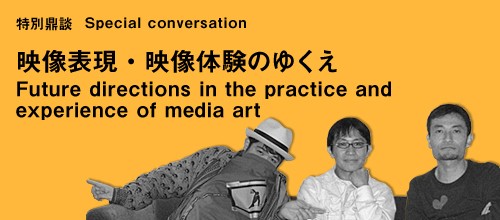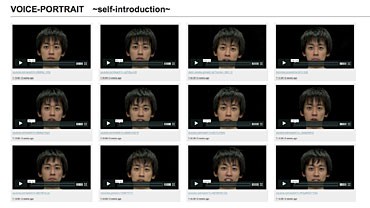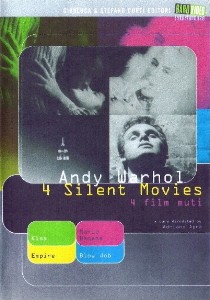
Ukawa Naohiro (CREAM competition juror)
Hachiya Kazuhiko (Participating artist)
Sumitomo Fumihiko (Director of the Festival)
Anyone can create their own video and watch all manner of video in this ‘media art paradise’ of recent years, a paradise in which such expression even strikes one as hackneyed. In what direction are the practice and experience of media art heading? Three people who were involved in different capacities in the International Festival for Arts and Media Yokohama consider the possibilities and issues surrounding media art.
Text: ART iT
– I’d like to kick off this discussion of the current state and future of the practice and experience of media art by asking about the CREAM Competition at this year’s festival, which was open to the public. The grand prize, the CREAM Prize, went to VOICE-PORTRAIT ~self-introduction~ (Matsushima Shunsuke).
 Matsushima Shunsuke VOICE-PORTRAIT http://voice-portrait.tumblr.com
Matsushima Shunsuke VOICE-PORTRAIT http://voice-portrait.tumblr.comUkawa Naohiro This was a work in which the audio was extracted from various self-introduction videos posted on the Internet and synchronized with visuals of the same male character lip-synching the dialogue in each one. Technique-wise it’s similar to Haruna Ai’s Air Ayaya performances, but the emphasis on the use of the facial muscles to express the meaning is new, isn’t it?
Hachiya Kazuhiko Right…. If you just watch the first one it looks like a normal self-introduction. But in fact in each video the voice and the things they’re talking about belong to completely different people.
Sumitomo Fumihiko He posted a number of these YouTube videos on the Internet using Tumblr, and if you follow the links at the bottom of each video you can see the original self-introduction videos of the people whose voices he borrowed. The actual owners of the voices include a host with a crazy hairstyle and a number of girls. Ironically, the fact that the line indicating the boundary of the artist’s own work is vague is something the judges valued highly.
UN Because it gained them so many hits on the Internet, the work had the effect of focusing even more attention on the personalities of the people actually talking, so to this extent it represents a novel approach to communication over digital networks.
– Ukawa-san, among the competition prize winners, I heard you were a bit concerned about …niland 1 (Rocio Rodriguez, Mariues Leneweit).
UN This one’s pretty crazy! It’s dark ambient (laughs).
Rocio Rodriguez, Mariues Lenewei) …niland 1 (digest)
SF It includes footage of a man and a woman moving around underwater, and the way the camera is rotated and so on gives it a strange floating sensation. It’s a simple trick, but it then shows fish swimming up and here CG are used so that the fish alone aren’t inverted. Overall it has a real ambient feeling and aesthetically speaking achieves a high degree of perfection.
UN It’s a dark video with a hint of black magic. It’s a work in which human emotions are trapped in an almost suffocating atmosphere of tension in a way that’s almost sickening. You could almost regard it as video sorcery. In that respect you can definitely detect the spirits of dead people in the noise. At first I thought it might have been submitted by Fujiko A Fujio (laughs).
HK This was from overseas… by a pair of artists based in Spain.
SF Overall it was a variegated line-up in many respects, with one of the judges for the final selection, Asai Takashi (president of UPLINK Co.), commenting that “it was as if entrants in the long jump and 100m at the Olympics were competing in the same event”. Another thing that made it difficult was that judges in different fields such as film, media art, and so on tend not to pick ‘things that are commonplace’ in their respective fields even if they are of a high quality.
‘Five hundred million Warhols’ and live cameras
SF In terms of numbers, too, the competition was perhaps dominated by blog-like documentaries. Even the more traditional documentary videos tended to take the form of compilations of everyday scenes shot with no apparent attachment rather than something in the style of Hara Kazuo (Note: Film director. Created from the 1970s onwards a series of singular works that focus on the ‘indistinctness of the line between fact and fiction’ of documentary films).
HK I saw a similar thing the other day on NHK. They simply shot in a completely unattached way people coming into what looked like an old-fashioned penny candy store in Akita to talk to the owner. (Bokutachi no Hokago – Akita: Aru Shokudo no Monogatarai) So there was a student from the technical high school across the road talking about what they intended to do after graduating and a girl who couldn’t communicate very well who came in and said something and then left. It’s like, you think something interesting is going to happen but actually nothing of any consequence does, and before you know it 20 minutes have elapsed (laughs).
UN These days, instead of the traditional ‘super personal’ documentaries in which the filmmaker captures the moments of drama in our mundane everyday lives, it’s as if the mere everyday effluence one sees on the kinds of video distribution sites that pander to the ‘voyeuristic sensibility’ of the viewer and their craving for this kind of thing, along with the fetishism of this, have become generally acknowledged. Because they’re not necessarily made with screening in theatres in mind, basically nothing happens. Yet, maybe just for a moment something will. In other words, they’re documentaries in the form of one-off accidents in which you don’t necessarily want to see someone bathing but in which the reality of seeing a momentary panty shot in the middle of an unexpected file is actually more exhilarating (laughs).
My feeling is the collection of 16mm videos shot by Andy Warhol also strike more or less at the essence of these post-YouTube era documentaries. Couch and Kiss are cases in point, as is Sleep, of course, since it’s simply eight hours of someone sleeping (laughs). The face he makes six-and-a-half hours from the start when he clenches his teeth is dodgy – things of that nature. In fact I think I’ve already reached my conclusion for the topic of today’s discussion, which is that the pinnacle of the media art that typifies what we’re seeing this century is the live camera. Empire, for example, which depicts a skyscraper, is precisely live camera footage, and some people say the original was 24 hours long. Of course nothing happens, but playing it would bring with it the charm of being able to experience vicariously the everyday time axis of the artist once being there, and in fact in recent years in various places everyday scenes like those in Empire are being captured around the clock. In other words, the situation we have today in which the world is overflowing with live camera footage is one in which tens of millions of Warhols are unconsciously shooting Empire 24 hours a day. No one is seeking drama or anything to begin with, so you could say there’s scarcity value in the one-off accidents that on rare occasions do occur.
 DVD Andy Warhol: Four Silent Movies
DVD Andy Warhol: Four Silent Movies (Kiss / Empire / Blow Job / Mario Banana)
Italo DVD
Video sites like Ustream are full of footage of newly born puppies. It’s at this time that the mother and her pups are usually in the cage together and also that the pups grow quickly, so they’re ideal subjects for the live cameras that have found their way into homes everywhere. The sense that people all around the world are watching pets whose owners they’ve never met grow like foster parents is something born out of the technology of this century. In his manifesto, Dziga Vertov wrote of the most important thing in the world being to sense the world in a cinematic way, but this century the meaning of this is in the process of changing from Man with a Movie Camera to Man who Installed a Movie Camera.
HK It’s the same at my company, where I noticed the staff were spending an awful lot of time looking at their computer screens and found they were all watching live camera footage of a Common Kestrel nest. The location is Basel, or so I’m told, and what the staff were watching endlessly were things like the chicks molting and the parents bringing them food. And when all the chicks left the nest and it was empty it was sooo heartbreaking (laughs).
SF Although even before the development of the Internet there were signs of this same sensibility, weren’t there? Something I didn’t know until I read it in a book written by a producer at the TV Man Union (a television production company) is that when all the TV stations broadcast live coverage of the 1959 wedding of the Crown Prince (now the Emperor) and Michiko-sama, while all the other channels went to commercials, Nippon Television alone broadcast footage of the crowd at the ceremony hall simply milling around. By doing this they apparently got higher ratings than the other channels that carefully put together shots of the highlights of the ceremony and commercials. It was this that made people realize that ‘television was all about live broadcasting’.
Ukawa Naohiro
Born 1968 in Takamatsu. Media artist, VJ, writer, graphic designer. Director of MOM/N/DAD PRODUCTIONS and Mixrooffice. Lecturer in the Image Media Course, Department of Information Design, Kyoto University of Art and Design. Launching the live-streaming studio, DOMMUNE, in Hiroo in 2010.
http://www.ukawa.tv/
Hachiya Kazuhiro
Born 1966 in Saga. Media artist. Known as the developer of the email application PostPet, he is also director of Petworks, a company engaging in PostPet-related software development and direction.
http://www.petworks.co.jp/
Sumitomo Fumihiro
Born 1971 in Tokyo. Following curatorial posts at the 21st Century Museum of Contemporary Art, Kanazawa in preparation for its opening, NTT InterCommunication Cener (ICC) and the Museum of Contemporary Art Tokyo (2006-08), acted as director of the CREAM International Festival for Arts and Media Yokohama. He is also a founding director of the non-profit Artists Initiative Tokyo (AIT).
http://ifamy.jp/
Next > (The possibilities of audience-involvement-type projects)
